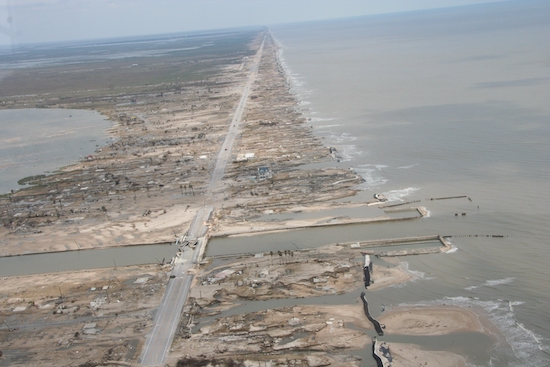SEJournal Online is the digital news magazine of the Society of Environmental Journalists. Learn more about SEJournal Online, including submission, subscription and advertising information.
Inside Story: Award-Winner Looks Ahead to Prospects of a Perfect Storm
 |
| Storm surge damage caused by Hurricane Ike in 2008. PHOTO: NOAA/Houston/Galveston National Weather Service Forecast Office; Houston OEM; Flickr Creative Commons |
The Texas Tribune and ProPublica last year published a special project on how a major hurricane in Houston could kill thousands and cripple the national economy. In late April, the interactive multimedia “Hell and High Water” package won a Peabody Award for what the judges said was a “collaboration that weaves cutting-edge climate science, digital mapping tools, engineering simulations, on-the-ground reporting, and compelling photography to tell the story of Houston’s current and future vulnerability to dangerous flooding resulting from global warming.”
SEJournal Editor A. Adam Glenn had previously spoken with the project’s Neena Satija about the work, what brought her to it and how she was able to address the particular challenges of covering prospective extreme weather. Here’s an encapsulation of that conversation.
“Whoa, we are clearly not prepared for this.”
That’s what journalist Neena Satija found herself thinking the night of Oct. 29, 2012, as Hurricane Sandy bore down on the Connecticut coast and she watched Gov. Dannel Malloy take to the airwaves, pleading with residents to find high ground as flooding threatened.
Sandy passed and sheer luck spared the state the worst possible scenario of its impacts. But did officials acknowledge the averted disaster? Not in her view. “All of a sudden talk about vulnerability was over,” she recalled. “No one wanted to talk about what could have happened.”
So Satija took up the task herself. Then a reporter for the Connecticut Mirror and Connecticut Public Radio, she went on to produce a 2013 SEJ Award-winning report on shoreline vulnerability in Fairfield County, as public housing residents nervously await the next storm.
But as Satija later learned, this narrative of disaster sidestepped then forgotten is far from unique. In 2013, after moving to Texas to become an investigative reporter and radio producer for Texas Tribune and Reveal, she heard virtually the same story about 2008’s Hurricane Ike.
Although Ike was the third most costly hurricane to hit the United States after Sandy and Katrina, Satija discovered little official action had been taken to insure the state was ready for another big hurricane.
Again, Satija and team dug into the story, this time in partnership with the news powerhouse ProPublica. Working with data wizard Al Shaw, they were able to create high-impact visualizations of worst-case scenario hurricane hits using models developed by researchers at Rice and Texas A&M universities, as well as at the Federal Emergency Management Agency.
Hell and High Water, published in March 2016 (and in a podcast for Reveal), demonstrated that Texas remains unprepared for a major storm that could leave thousands dead and cripple Houston’s massive petrochemical and the nation’s economy.
Getting past the hypotheticals
But depicting the scenarios was only one step in driving the dangers home.
One pitfall Satija wanted to avoid in her reporting on Texas hurricane preparations was that many risks and potential solutions remained hypothetical. This allowed sources to avoid answering challenging questions and to finger-point at other stakeholders amidst the gridlock.
But working with Shaw on the hurricane modeling’s geodata set now meant the team could get past those hypotheticals, at least in terms of the dangers, and pinpoint specific neighborhoods that were facing the highest risk of flooding during a storm.
Reporters then went door-to-door in those subdivisions to find individual subjects who had already suffered from past flooding and who could talk about their fears of future inundations. A second, follow-up report, Boomtown, Floodtown, published in December 2016, exposes the ways in which Houston’s explosive development has left residents vulnerable to repeated floods.
It’s when you look at human impact
that it really gets people to pay attention
That focus on human impacts in the web report and in the Reveal podcast, Satija said, was inspired by the past hurricane coverage of other journalists, like SEJ member Mark Schleifstein and his award-winning coverage of levee risks and of Hurricane Katrina as environment reporter for NOLA.com/The (New Orleans) Times-Picayune.
“We talked to him about how you bring it to life when there are hypotheticals,” she recalled. “It’s when you look at human impact that it really gets people to pay attention. People had to admit if Houston had this [potential] hurricane, thousands could die and the economy grind to halt.”
Find specific, and local data
Also crucial to such reporting, Satija argued, is a direct connection with scientists who developing increasingly robust climate-related data.
“Get to know climate scientists who are studying your area,” she advises other journalists. “Get as specific as you can about what can be expected in next five to 10 years or so, especially in coastal areas with sea-level rise, which is some of the most irrefutable data.”
Satija sees such preparedness coverage as part of a growing nexus of beats, not just traditional environment and energy coverage, but urban and political reporting, as well as the demographics of affected populations, or impacts on agriculture and food security issues.
That’s particularly useful in places like Texas. “In states where governors are questioning climate change,” she noted, “it’s a way to talk about the subject and have a meaningful conversation.”
EDITOR'S NOTE: Reporting from this story also appeared in a feature on climate adaptation for Poynter.org.
* From the weekly news magazine SEJournal Online, Vol. 2, No. 23. Content from each new issue of SEJournal Online is available to the public via the SEJournal Online main page. Subscribe to the e-newsletter here. And see past issues of the SEJournal archived here.












 Advertisement
Advertisement 



